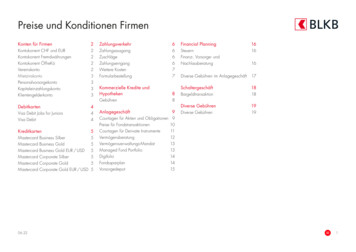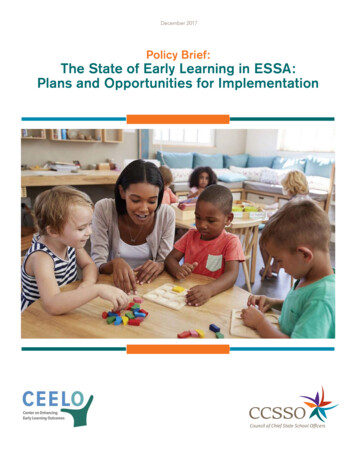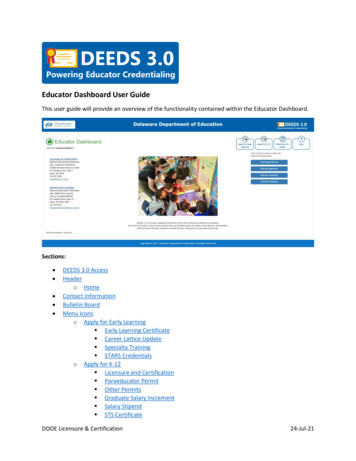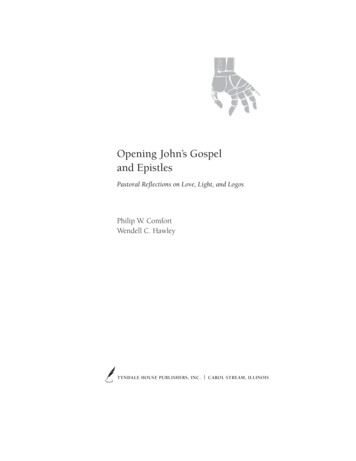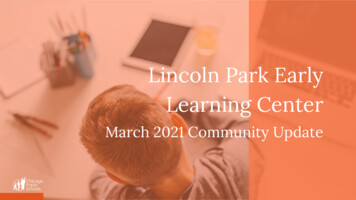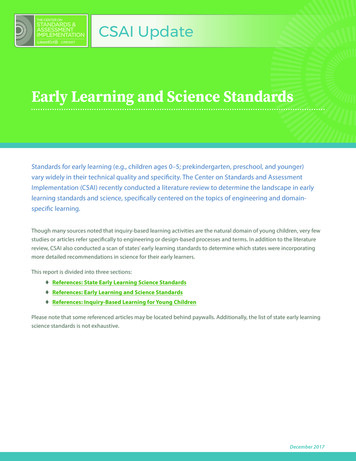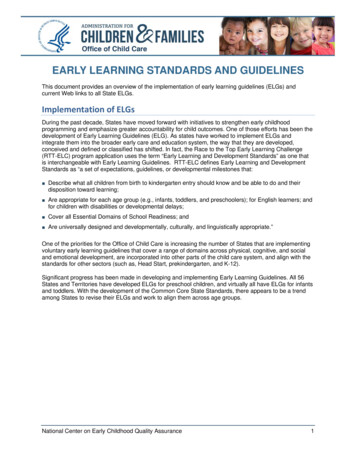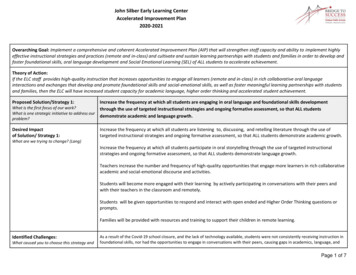
Transcription
John Silber Early Learning CenterAccelerated Improvement Plan2020-2021Overarching Goal: Implement a comprehensive and coherent Accelerated Improvement Plan (AIP) that will strengthen staff capacity and ability to implement highlyeffective instructional strategies and practices (remote and in-class) and cultivate and sustain learning partnerships with students and families in order to develop andfoster foundational skills, oral language development and Social Emotional Learning (SEL) of ALL students to accelerate achievement.Theory of Action:If the ELC staff provides high-quality instruction that increases opportunities to engage all learners (remote and in-class) in rich collaborative oral languageinteractions and exchanges that develop and promote foundational skills and social-emotional skills, as well as foster meaningful learning partnerships with studentsand families, then the ELC will have increased student capacity for academic language, higher order thinking and accelerated student achievement.Proposed Solution/Strategy 1:What is the first focus of our work?What is one strategic initiative to address ourproblem?Desired Impactof Solution/ Strategy 1:Increase the frequency at which all students are engaging in oral language and foundational skills developmentthrough the use of targeted instructional strategies and ongoing formative assessment, so that ALL studentsdemonstrate academic and language growth.Increase the frequency at which all students are listening to, discussing, and retelling literature through the use oftargeted instructional strategies and ongoing formative assessment, so that ALL students demonstrate academic growth.What are we trying to change? (Lang)Increase the frequency at which all students participate in oral storytelling through the use of targeted instructionalstrategies and ongoing formative assessment, so that ALL students demonstrate language growth.Teachers increase the number and frequency of high-quality opportunities that engage more learners in rich collaborativeacademic and social-emotional discourse and activities.Students will become more engaged with their learning by actively participating in conversations with their peers andwith their teachers in the classroom and remotely.Students will be given opportunities to respond and interact with open ended and Higher Order Thinking questions orprompts.Families will be provided with resources and training to support their children in remote learning.Identified Challenges:What caused you to choose this strategy andAs a result of the Covid-19 school closure, and the lack of technology available, students were not consistently receiving instruction infoundational skills, nor had the opportunities to engage in conversations with their peers, causing gaps in academics, language, andPage 1 of 7
John Silber Early Learning CenterAccelerated Improvement Plan2020-2021what data supports the need for it?social skills development. In addition to the lack of technology, families struggled with constant communication and participation withthe school due to medical conditions, housing instability, nutritional deficits, financial constraints, and emotional trauma.Due to the Covid-19 school closure, we do not have Fountas and Pinnell end of the year data to establish a reasonablebaseline for decision making.Resources/Assets:What are the strengths of the school and/ordistrict and supports available to the schoolto implement this strategy?Resources/ Supports: The ELC will be prioritizing oral language opportunities within daily classroom schedules to maximize studentlanguage development ELL and Reading services will continue to be offered. PLT collaboration system Ongoing grade level and leadership team data meetings. Coaching from Curriculum, Inclusion, ELL Specialists and Literacy Coaches Staff members are trained to provide parent workshops focusing on supporting children’s development. District support of different platforms so that students have access to individual online learning opportunities(DiscoveryEd, Seesaw, PebbleGo, Epic, Imagine Learning, etc.) SLT meetings and Elementary/ELC Collaboration Support from the District Literacy and Math Coordinators The use of the Focus Feedback Form ELC Google site for parent communication and informationMeasures of Change of Solution/Strategy 1: What outcome indicators do we use to measure success throughout the year?Adults:What & when?CVT #CVT#6(ratings of 4)Baseline:57%November Target:60%February Target:70%June Target:77%Page 2 of 7
John Silber Early Learning CenterAccelerated Improvement Plan2020-2021CVT ratings will be dependent on in-class instruction.Teacher self-assessment will be created to measure teacher use of targeted instructional strategies both in-class andremote.Students:What & when?50% of students who score Needs Improvement or Warning in the Fall Literacy Developmental Growth Rubrics (DRGs) willmove to Proficient or Above by Spring.60% of K students will achieve “End of Year Benchmark” in the area of Nonsense Word Fluency on the DIBELSassessment. (In-class dependent)80% of PK students will show growth in the area of math foundational skill PK CC.4. (monthly informal assessments, mathassessment, anecdotal notes)80% of K students will show growth in the area of math foundational skill K.CC.1. (monthly informal assessments, mathassessment, anecdotal notes)80% of First Grade students will show growth in the area of 1. NBT.2. (exit tickets, anecdotal notes, math assessments)90% of Level 1 and 2 English Language Learners in General Education Kindergarten and First Grade who have beenenrolled at the ELC since October 31, 2020 will increase one level on the Language Developmental Continuum. (90% goalpending in-class, 75% pending remote learning)75% of a cohort of 20 Kindergarten students randomly sampled from across all General Education classrooms willincrease at least one level on the Language Developmental Continuum.All First Grade students will show growth in Oral Vocabulary in Imagine Learning.85% of Students in Substantially Separate classrooms that have been enrolled in the ELC since October 31, 2020 willincrease at least 9 points on the language and academic sections of the Pre-K/ K Special Education Development of Skillsrubric.Measures of Implementation ofSolution/Strategy 1: Use of CVT for instructional strategies for in-class instruction.Use of ELC Focused Feedback Form (FFF), with a focus on instructional strategies and student engagement.Ongoing PD to promote strategies that support language development, technology, and remote learning, movingPage 3 of 7
John Silber Early Learning CenterAccelerated Improvement Plan2020-2021How do we hold ourselves accountable forthe work and outputs? what & when? Proposed Solution/Strategy 2:What is the second focus of our work?What is our second strategic initiative toaddress our problem?Desired Impactof Solution/Strategy 2:What are we trying to change? (Lag)Identified Challenges:What caused you to choose this strategy andwhat data supports the need for it?us towards students developing oral language and vocabulary.Teachers will implement interactive read-aloud strategies as measured by classroom observation/FocusedFeedback Form data (remote and/or In-class) and CVT tool (in-class).ELC Google Site with section including activities and videos for teaching foundational skills at home.Family trainings through Zoom for foundational skills and oral language development.Cultivate and sustain effective learning partnerships with students and families to support continuous development ofsocial emotional learning aligned to the CASEL standards through the use of evidence based practices in order tocreate a trauma informed, culturally responsive, and anti-racist school environment (remote and in class) so thatstudents can successfully access the curriculum.Students will develop and demonstrate increased social and emotional skills including self awareness, self management,social awareness, relationship skills, and responsible decision making resulting in an increase in students participating inpositive shared social learning experiences.As a result of the Covid-19 school closure, and the lack of technology available, students were not consistently receiving instruction infoundational skills, nor had the opportunities to engage in conversations with their peers, causing gaps in academic, language, andsocial skills development. In addition to the lack of technology, families struggled with constant communication and participation withthe school due to medical conditions, housing instability, nutritional deficits, financial constraints, and emotional trauma.Students and families may have increased anxiety about going to school, separating from parents, being in public spaces.The constant transition between in class and remote learning may be challenging for our young students to adjust to andmanage.Resources/Assets: What are the strengths of the school and/ordistrict and supports available to the schoolto implement this strategy? The schedule will prioritize time for SEL skill mini-lesson instruction, as well as time for students to play, socializeand apply’ social-emotional learning on a daily basis (remote and in-class).Teachers have been trained in how to engage students in play and in how to support student social emotionaldevelopment.PLT Collaboration SystemParent Liaison works closely with community organizations to provide essentials to families.Two coaches and one SLP trained in providing parent training in Pyramid Strategies for families.Social workers available to support students, families, and teachers prior to and during the school year.SEL Lead and subcommitteeThe use of the Focus Feedback FormPage 4 of 7
John Silber Early Learning CenterAccelerated Improvement Plan2020-2021Measures of Change of Solution/Strategy 2: What outcome indicators do we use to measure success throughout the year?Adults:what & when?Data Measures from the CPS Pandemic Response Survey of Student and Staff Well-Being and Engagement once createdand implemented.75% of families will participate in remote learning through online learning platforms.Students:what & when?SEL Assessment:-50% of general education students who score Needs Improvement or Warning on the Fall SEL Developmental GrowthRubric (overall score) will move to Proficient or above by Spring.-30% of general education students who score Needs Improvement or Warning on the Fall SEL Developmental GrowthRubric in the area of SEL 4 Self Management--Demonstrates Impulse Control and Stress Management (our lowest area)will move to Proficient or above by Spring.85% of Students in Substantially Separate classrooms that have been enrolled in the ELC since October 31, 2020 willincrease at least 5 points on the Social Emotional section of the Pre-k/ K Special Education Benchmark Rubric Assessment.Measures of Implementation ofSolution/Strategy 2: How do we hold ourselves accountable forthe work and outputs? what & when? Teachers will explicitly teach social and emotional skills each day in the designated SEL/PBS time as measured byFocused Feedback Form (in-class and remote)Teachers will continue to foster social and emotional skill development throughout the dayMonthly PLT’s focusing on Social Emotional Learning (in-class and remote)Continued SEL PDMonthly SEL check-in during staff meetingCPS Pandemic Response Survey of Student and Staff Well-Being and EngagementPD Focusing on anti-racism and anti-bias topics through the use of appropriate literatureELC Google Site with section including activities and videos for teaching Social Emotional skills at home.Family trainings through Zoom for Social Emotional skills.Page 5 of 7
John Silber Early Learning CenterAccelerated Improvement Plan2020-2021Page 6 of 7
John Silber Early Learning CenterAccelerated Improvement Plan2020-2021Page 7 of 7
John Silber Early Learning Center Accelerated Improvement Plan 2020-2021 Page 1 of 7 Overarching Goal: Implement a comprehensive and coherent Accelerated Improvement Plan (AIP) that will strengthen staff capacity and ability to implement highly effective instructional strategies and practices (remote and in-class) and cultivate and sustain learning partnerships with students and families in .


